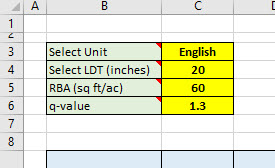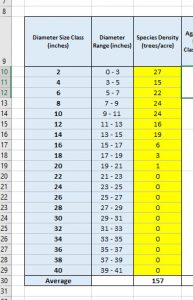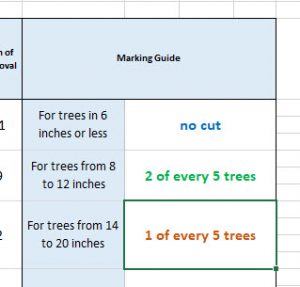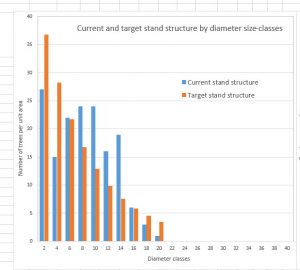Application of the Pro-B Method
The Proportional Basal Area Method was designed to make marking a stand with an uneven-aged prescription as easy and straight forward as marking a thinning operation. As discussed on the Historical Approaches page, most foresters have been exposed to various theories for managing an uneven-aged stand, but few have experience or are comfortable in actually marking those stands for harvest.
The following methodology is striped down to the bare bones. Additional information to include detailed explanation, background, and examples are linked where appropriate. Basic assumptions are noted and user modifications that can be made to the base model coefficients are described.
1. Inventory
Conduct a stand inventory by species and diameter at breast height. At a minimum, you need a per unit area estimate of density by 2-inch (5-cm) diameter class. The inventory should include trees down to the 6-inch class (lower is better).
2. Analysis
Download the Pro-B calculator (if asked for an e-mail address, simply close the dialog box). The file defaults to read-only; save-as to your computer to allow editing.

Define the diameter structure of your residual stand.

Default values are shown above.
- Values for largest diameter tree (LDT) should be no larger than the largest trees in your current inventory. If your desired future condition includes larger trees, this value should be modified in future cutting cycles only when those larger trees are present in the stand.
- Determine your desired residual basal area of the stand. This should be a function of the shade tolerance of your desired species (potentially modified by the shade tolerance of their competitors). See discussion under ecological foundations.
- q-value controls the depletion curve (see discussion under ecological foundations).
Input your inventory data into the calculator in the yellow highlighted column:

The marking guide (as well as graphic depictions of the current and target diameter distributions) are automatically generated.


3. Marking the stand
Consider any constraints, restrictions, or rules that the timber marker should consider when selecting individual trees for removal or retention (these will be a function of the landowner’s objectives). Common rules might include (but are not limited to):
- take the worst and leave the best
- remove less desirable species
- adjust spacing to release residual trees
- retain potential snags or live cavity trees
Part of the efficiency of the Pro-B method is that all trees fall into only one of three size classes (four classes if trees larger than 20-inches are retained) for marking purposes. Thus, the number of trees that are near those class boundaries and might need measurement is fairly small. Until the marker develops proficiency in ocular estimation of diameter, they should measure any stem that is borderline.
Video of pre-marking size class calibration
Using our example above, the marking instructions are:
- Mark no trees 6-inches DBH or below
- Mark 2 of every 5 trees between 8 and 12 inches DBH
- Mark 1 of 5 greater than 14 inches
Because these are 2-inch size classes the actual cutoffs between classes are 7 inches and 13 inches respectively.
Pro-B is truly a one-pass method for marking a selection stand. As a timber marker enters the stand (again using our example above), they ignore any stems < 7 inches DBH. Of the first 5 trees they encounter in the 8 through 12 inch class, they mark 2 of them; of the first 5 trees in the 14 inch or larger classes they see, one should be marked. Thus, the proper proportion of removal is taken as the marker moves throughout the stand. If there are portions of the stand that have few or no large trees, then in those locations, few or none are marked. Where density is higher, the marking becomes heavier, again in direct proportion to the prescribed removal rate.
Video of density dependent marking
Video of Pro-B marking around natural gap
Video of crew marking a longleaf pine stand
A common question is, what should be done when there are 4 or 5 high quality trees together and the guide says to mark 2 of them? The answer is, mark two of them…adjust spacing or remove the two worst of those five high quality stems; follow the proportional rate of removal. Similarly, if a section of the stand is of inferior quality, follow the proportions even though it means leaving the best of the worst trees in that location. You are still managing growing space vertically through the canopy and horizontally across the stand.
Video of stand marked/pre-harvest
Last modified: